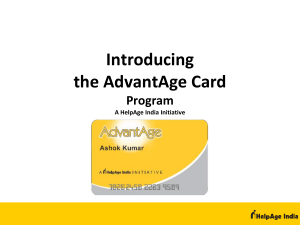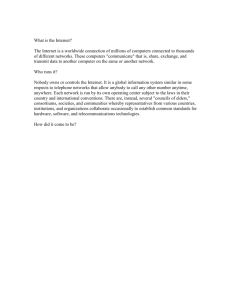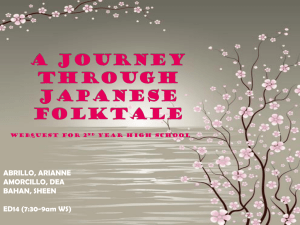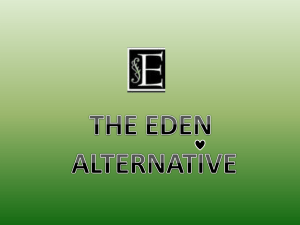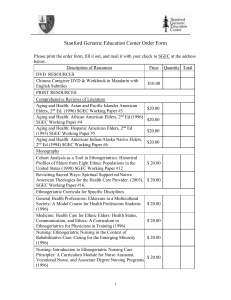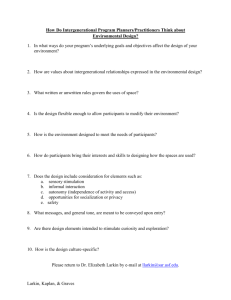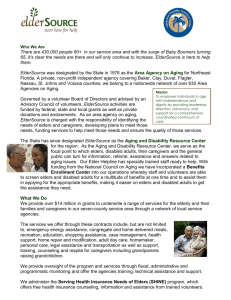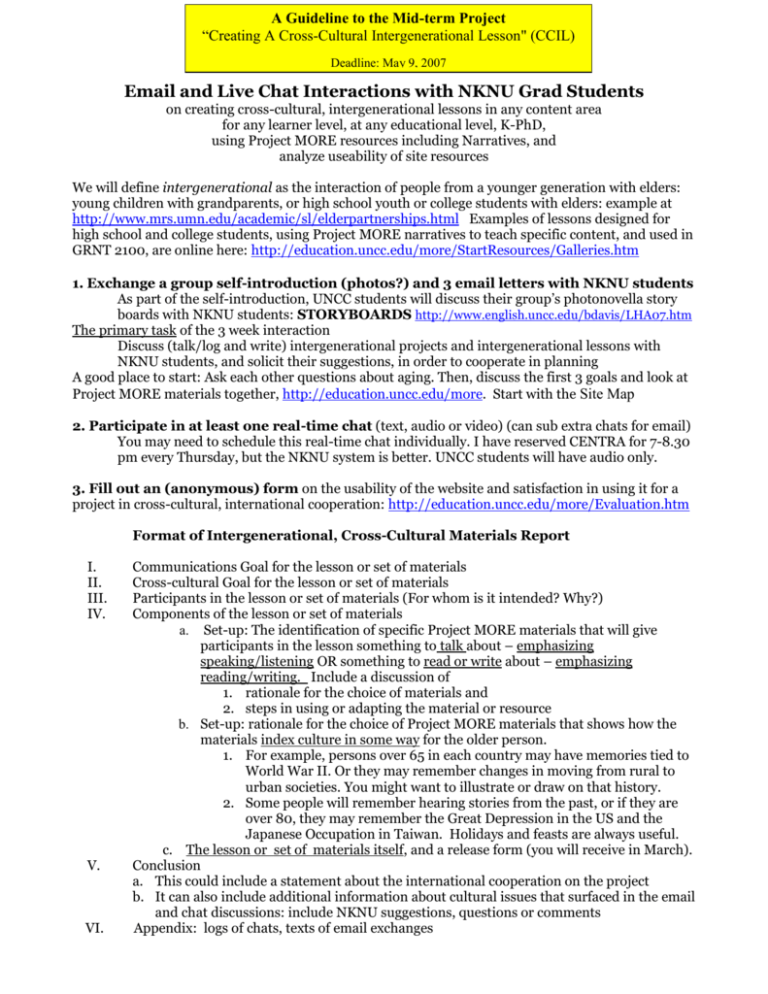
A Guideline to the Mid-term Project
“Creating A Cross-Cultural Intergenerational Lesson" (CCIL)
MARCHDeadline:
GROUPMay
ASSIGNMENT
9, 2007
Email and Live Chat Interactions with NKNU Grad Students
on creating cross-cultural, intergenerational lessons in any content area
for any learner level, at any educational level, K-PhD,
using Project MORE resources including Narratives, and
analyze useability of site resources
We will define intergenerational as the interaction of people from a younger generation with elders:
young children with grandparents, or high school youth or college students with elders: example at
http://www.mrs.umn.edu/academic/sl/elderpartnerships.html Examples of lessons designed for
high school and college students, using Project MORE narratives to teach specific content, and used in
GRNT 2100, are online here: http://education.uncc.edu/more/StartResources/Galleries.htm
1. Exchange a group self-introduction (photos?) and 3 email letters with NKNU students
As part of the self-introduction, UNCC students will discuss their group’s photonovella story
boards with NKNU students: STORYBOARDS http://www.english.uncc.edu/bdavis/LHA07.htm
The primary task of the 3 week interaction
Discuss (talk/log and write) intergenerational projects and intergenerational lessons with
NKNU students, and solicit their suggestions, in order to cooperate in planning
A good place to start: Ask each other questions about aging. Then, discuss the first 3 goals and look at
Project MORE materials together, http://education.uncc.edu/more. Start with the Site Map
2. Participate in at least one real-time chat (text, audio or video) (can sub extra chats for email)
You may need to schedule this real-time chat individually. I have reserved CENTRA for 7-8.30
pm every Thursday, but the NKNU system is better. UNCC students will have audio only.
3. Fill out an (anonymous) form on the usability of the website and satisfaction in using it for a
project in cross-cultural, international cooperation: http://education.uncc.edu/more/Evaluation.htm
Format of Intergenerational, Cross-Cultural Materials Report
I.
II.
III.
IV.
V.
VI.
Communications Goal for the lesson or set of materials
Cross-cultural Goal for the lesson or set of materials
Participants in the lesson or set of materials (For whom is it intended? Why?)
Components of the lesson or set of materials
a. Set-up: The identification of specific Project MORE materials that will give
participants in the lesson something to talk about – emphasizing
speaking/listening OR something to read or write about – emphasizing
reading/writing. Include a discussion of
1. rationale for the choice of materials and
2. steps in using or adapting the material or resource
b. Set-up: rationale for the choice of Project MORE materials that shows how the
materials index culture in some way for the older person.
1. For example, persons over 65 in each country may have memories tied to
World War II. Or they may remember changes in moving from rural to
urban societies. You might want to illustrate or draw on that history.
2. Some people will remember hearing stories from the past, or if they are
over 80, they may remember the Great Depression in the US and the
Japanese Occupation in Taiwan. Holidays and feasts are always useful.
c. The lesson or set of materials itself, and a release form (you will receive in March).
Conclusion
a. This could include a statement about the international cooperation on the project
b. It can also include additional information about cultural issues that surfaced in the email
and chat discussions: include NKNU suggestions, questions or comments
Appendix: logs of chats, texts of email exchanges
MARCH GROUP ASSIGNMENT
Dr. Boyd Davis (boydhdavis@yahoo.com)
English Department, University of North Carolina-Charlotte, U.S.A.
Bonnie E. Cone Distinguished Professor of Teaching, 1997
Professor of English, College of Arts and Sciences, 1980
Program Advisor: Applied Linguistics, 1995-2000; 2002—04
Director of Graduate Studies 2000-2002
Initial Teaching Licensure: Secondary English and French (K-12)
Visiting Professor at English Department, National Kaohsiung Normal University
2006
Latest Publication:
1. Boyd Davis (Ed). (2005). Alzheimer Talk, Text and Context; Palgrave-Macmillan: I.P.
2. Boyd Davis &Lisa Russell-Pinson. (2005). Going + to: An example of using a regional
corpus to answer questions in preparing healthcare materials. TELL Journal. 3, 1-12.
National Kaohsiung Normal University.
Honors and Adwards:
Harshini de Silva Mentoring Award, 2004 , Bonnie E. Cone Professorship in Teaching, 1997 , and more.
UNCC Students
Alicia Broadus
Ken Chadwick
Amanda Cloninger
Kristen Pierce
Anonymous1439299
Krystal Roach
Boyd Davis
Louise Murray
Carrie Holt
Mary Anne Ferguson
Chih-ling Liou
Melanie Rouse
Denise Bordeman
Muriel Harris
Emily Propst
Nicole McNair
Erica Forehand
Nikki Nikrooz
Erin Kerns
Paige Rosenbarker
Huang Chen
Renee Troccoli
MARCH GROUP ASSIGNMENT
Jason Sanderbeck
rhonda kinsey
Dr. Boyd Davis’ Notes
1. Definition of terms: I will define intergenerational as the interaction of people from a younger
generation with elders. The younger generation could be young children with grandparents, or
high school youth or college students. There is an example here:
http://www.mrs.umn.edu/academic/sl/elderpartnerships.html Examples of lessons designed for high
school and college students, using Project MORE narratives to teach specific content, are online in
Project MORE’s Intergenerational Gallery
2. Italicized terms: these are to remind my students of the terms in the S P E A K I N G mnemonic
developed by Hymes (1972) to describe the components of any communicative interaction. You’ll
find a handout called Labov&Hymes in the folder at
ftp://140.127.60.124/Davis/nknuL&C/Readings/
Elder
Partnerships
MARCH G
ROUP ASSIGNMENT
http://www.mrs.umn.edu/academic/sl/elderpartnerships.html
• Service Learning
UMM Home > Service Learning > Elder Partnerships
Elder Partnerships
What Is Service Learning?
Schedule of Events
Gallery of Advanced Photography
Photos-Spring 2006
Why is the Elder Partnership Initiative Important to West Central Minnesota?
Spring 2007 Classes
Fall 2006 Classes
Spring 2006 Classes
Advisory Board
Program Review - 2006
List of Community Partners
History
Photo Archive
• Information for:
Students
Faculty
Community Partners
Student Ambassadors
• Initiatives
Arts and Culture
Elder Partnerships
Youth Mentorship
Regional Agriculture
Contact
Home
Elders offer many assets to our community, including stories of our history and leisure time to contribute to comm
projects. Several resources are available in West Central Minnesota to enrich the lives of elders and encourage
intergenerational interactions, including a Senior Center that provides meals and activities, two assisted living fac
one long-term care facility in the city of Morris alone. In addition, our rural community has many advantages over
cities in that other formal and informal systems, including local churches, families, and neighborhood networks, e
support people as they age and to encourage dialogue across ages and experiences.
At the same time, our partners note that as our population ages and medical technologies improve, more and mo
are living longer lives. This means that many elderly people live with chronic conditions and require care from fam
members or staff at care facilities. These staff and families report that they are stretched in terms of both resourc
time. In rural areas, including ours, many young people and families are leaving for larger, metropolitan areas to
jobs or educational opportunities. Their parents and grandparents often choose to stay in their hometowns, leavin
elders without nearby family and fewer opportunities for intergenerational interactions.
In addition, our students come from a variety of backgrounds, and many have had few interactions with elders in
families or communities. Students live, work, and learn in a somewhat insular community with little age diversity.
benefit from interacting with elders because such interactions help them build valuable skills, such as interacting a
abilities and life experiences. In addition, interactions with elders encourage a broader understanding of the histor
community and nation.
The elder partnership initiative seeks to involve elders of all ages, walks of life, and with a wide range of abilities
directly in the community through intergenerational partnerships with elder care facilities and individual elders. W
do this by:
Involving elders and students in reciprocal, educational, and community-building projects that benefit s
elders and the agencies that serve them.
Involving elders with physical and/or cognitive limitations in planned activities that meet particular need
objectives determined by their families or care staff.
Providing elders and students with opportunities they would otherwise not have to interact with people
ages and cultures.
Supporting caretakers with significant resources (particularly volunteer time) that they would otherwise
MARCH GROUP ASSIGNMENT
Current Community Partners
West Wind Village
Lisa Denzer
1001 Scott Avenue
Morris MN 56267
Phone: 320.589.7902
West Wind Village is a residential care center that was established in
1963. The care center was operated by area nuns whose primary
goal was to provide a Christian commitment to caring for others.
Today, West Wind Village is under the operation of Saint Francis
Health Services. Their motto is: We are committed to expressing
Christ’s message of love and hope by providing for health,
residential, community, and allied services in a holistic, competent,
and caring manner that recognizes the value and dignity of every
human life.
West Wind Village aims to:
Provide care for the whole person: body, mind, and sprit.
Respect life, self, colleagues, and others.
Practice servanthood--a Christian commitment to unselfishly caring for others.
Maintain creativity in thinking and planning.
Collaborate effectively with persons, services, and businesses that are essential to fulfilling our vision.
Morris Senior and Community Center
Judy Nord Johnson, Stevens County Coordinator on Aging
603 Oregon Ave.
Morris, MN 56267
Phone: 320.589.1514
The senior center serves as a center for seniors to meet
and engage in various activities. Some of these activities
include: socializing, crafts, quilting, playing cards, bridge,
and other games. Additionally, the Morris Senior and
Community Center offers well balanced and tasty meals
served from the kitchen at noon daily (except Sunday.)
These meals are provided by a separate organization
known as Nutrition Services Inc. The meals are available
to seniors
and the
public for
$3.50.
Meals on
Wheels
operate from the center and they provide meals to tho
get to the
center.
Grandview
Barb Kill
Morris, MN
Apartments
100 S. Columbia Ave
56267
320.589.3142
Current Needs:
Reading and writing mail for seniors
Intergenerational activities
Reading to groups of seniors to bring back m
Helping with the serving of meals at noon
Music and Drama activities
Teaching seniors computer skills
MARCH GROUP ASSIGNMENT
Skyview Court
Sue Amundson
1000 Court Drive
Morris, MN 56267
320.589.0245
Skyview Court was the first assisted living center in the area and provides a unique and appealing setting for the
who call it home. The facility offers the privacy and independence of apartment living with the comfort and convi
having on-site assistance. Skyview Court also offers a large common area, planned social events, and group dinin
to enhance the living experience.
Examples of Current and Former Courses Participating in the Elder Partnership Initiative
Eng 2121: Intro to Creative Writing- Ongoing Course
Argie Manolis
Students will plan and implement weekly activites for elders living at West Wind Village, many of whom suffer from
Alzheimer's disease or related dementia, while crafting and revising original short stories and poems. Students wi
about the art of paying attention to the details of everyday life and the beauty in everyday speech by writing foun
from the words of the elders. The found poems will give students practice in creating titles and line breaks for poe
determining ways to use everyday life experiences as inspiration for their own creative work. The found poems an
reflections are collected into books and given to elders and their loved ones.
SOC 1101: Intro to Sociology- Ongoing Course
Jennifer Rothchild
This course is designed to introduce students to the field of sociology, exploration of societies and how they opera
actively thinking about the issues facing societies today, students will learn to examine life situations and the influ
societies and groups on people's lives, careers, hopes, fears and personalities. Students will work with West Wind
Morris Area Child Care to facilitate intergenerational activities.
ENG 1001: Fundamentals of Writing- Ongoing Course
Argie Manolis
Students plan and implement weekly activities for elderly residents of West Wind Village, many of whom suffer fro
dementia. They write a series of essays about their experiences. These students will also interview a local farmer
description of the farmer and his or her small, sustainable farm to be displayed with photos at the local foods mea
and to increase awareness of the benefits of buying local foods.
ENG 2993: Directed Study: Found Poetry and Service Learning- Ongoing Course
Argie Manolis
Students assist College Writing and Fundamentals of Writing students with planning and implementing weekly act
elders living at West Wind Village. They collect the elders' words and write a series of found poems for the elders
families.
Speech Communications 1061: Interpersonal Communication- Former Course
Rujira Rojjanaprapayon
In this course, students can elect to plan and implement reminiscence sessions and social opportunities with elder
at Grandview Apartments and to connect their experiences to course material in place of a research paper.
Psychology 3403: Developmental Psychology III: Adulthood, Aging & Death - Ongoing Course
Jacqueline Greenwood
Students and elders will participate in a community education course about aging in the community and plan even
meet the needs of elders in our community and enhance intergenerational interactions.
©2007 Regents of the University of Minnesota. All Rights Reserved
The University of Minnesota is an equal opportunity educator and employer
Trouble seeing text? | UMM Web Administ
Last Modified: Monday Novem

